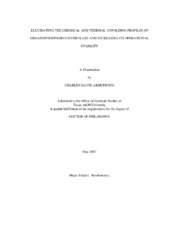| dc.description.abstract | Organophosphorus hydrolase (OPH, EC 3.1.8.1) is a homodimeric enzyme that
has been observed to unfold via a three-state unfolding pathway (N2* ↔ I2 ↔ 2U) under
chemical denaturing conditions. The dimeric intermediate (I2) is catalytically inactive
and, although this enzyme has a very large overall conformational stability (~40
kcal/mol), it takes only a small amount of energy (~4 kcal/mol) to unfold this enzyme
into its inactive form. So that this enzyme might be engineered as a more effective tool
for nerve agent countermeasures and bioremediation purposes, its operational stability
(the energy required to unfold the enzyme from its active, dimeric state to its inactive,
dimeric state) must be increased. For this purpose, it is necessary to understand how the
enzyme unfolds into its inactive, intermediate state.
As tryptophan residues are sensitive probes of the microenvironment surrounding
the residue, enzyme variants consisting of one tryptophan per subunit were constructed.
Unfortunately, these variant enzymes did not fold into active conformations, and so
could not be used to develop an accurate unfolding profile for the wild type enzyme. Limited proteolysis of OPH by thermolysin revealed detailed information on the
unfolding process of OPH in chemical and thermal denaturing conditions. Mild
denaturing conditions induced an initial enhancement of activity with a subsequent loss
of catalytic activity upon more aggressive treatment. Under thermal conditions from
35 – 55 °C, the enzyme developed a well populated and active intermediate that
displayed maximal activity. Similarly, the enzyme displayed maximal activity when
incubated at 1.0 M urea. The regions of the enzyme, which became accessible to
proteolysis at 45 °C and 1 M urea, were identical. This suggested that increased
flexibility of these regions was coupled with the increase in the enzyme’s catalytic
activity.
Two regions that were determined by limited proteolysis to be the first to unfold
were bridged with a novel disulfide bond. The result was an enzyme with an increased
operational stability and resistance to proteolysis. This enzyme retained approximately
70% of its original activity in 8 M urea while no activity remained for the wild type
enzyme when incubated in 6.5 M urea. | en |


